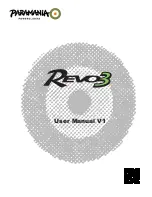
Next carry out the following pre flight checks:
Pilot prepared – clothing safe?
Helmet on and fastened?
Malions securely connected to risers (no twists)?
Trimmers set?
Nothing likely to foul the propeller?
Speed bar system running freely and out of harm’s way?
Steering toggles secure, brake lines free and not twisted?
Engine delivering full power?
Airspace is clear for take off?
Attach the wing and proceed with the launch (as in previous section).
From now on you should try to control the wing whilst facing forwards. If the wing is low behind you and you
turn around, the lines will trail over the propeller. However, falling backwards onto the motor is both danger-
ous and expensive and must be avoided at all costs, even that of a few damaged lines!
During the launch, if the pressure on each of your hands feels even, smoothly open the throttle to full take off
power. If you “trust the trust” leaning backwards against it will help, so that the engine is pushing you along
the ground rather than into it.
It is best to try and leave the brakes alone and just let the wing come up. If it starts to go off to one side,
move sideways and centre the wing, minimum brakes are required. Paramania have done a lot to ensure the
Revo3 has excellent directional stability during launch
As you increase power, try to maintain a constant angle with the motor and smooth power control. Any
sudden changes will alter your course because of the powerful gyroscopic and torque effects.
As the wing comes up the resistance reduces, so long as you keep moving and looking in the launch direc-
tion. If the wing is so far off to the side or behind that it cannot be recovered, kill the engine, abort the
take-off, and have another go.
Feel the wing, it will stabilize above without over-shooting. Allow your run to accelerate.
Only then, when you feel the resistance reduce is it a good time to check your wing, making sure it is nicely
inflated and that there are no tangles. This must be done whilst on the move and without slowing or turning.
Feel for pressure on the brakes, gently come down on them as required to steer or to increase lift for taking
off.
Points to note:
-
.So many pilots try to look at the wing as it is coming up, in doing so they usually upset the launch. This is
because when looking they turn their body at the same time, both changing the thrust line and asymmetrically
twisting the risers.
. If your propeller protection cage is flimsy, the pressure of the lines on it during launch may distort it to the
point where it fouls the prop. If this is the case make sure the lines have cleared the cage before you open
the throttle.
. All control inputs should be smooth and progressive.
. Don’t attempt to take off if the wing isn’t definitely overhead. Dangerous oscillations may result if you apply
full power with it too far off to one side.
. Keep your undercarriage (legs) down until you are definitely flying!
. The faster the trim setting, the more brake the wing will need to get off the ground.3.1b In Flight
In flight the Revo3 flies its self, It quickly recovers from most inputs a pilot can throw at it. We recommend
that slow trimmers are used to begin with.
Содержание Revo3
Страница 1: ...User Manual V1 ...
Страница 20: ...146 6F 44 33 26 20 56 54 1 2 0 3 26 ...


































